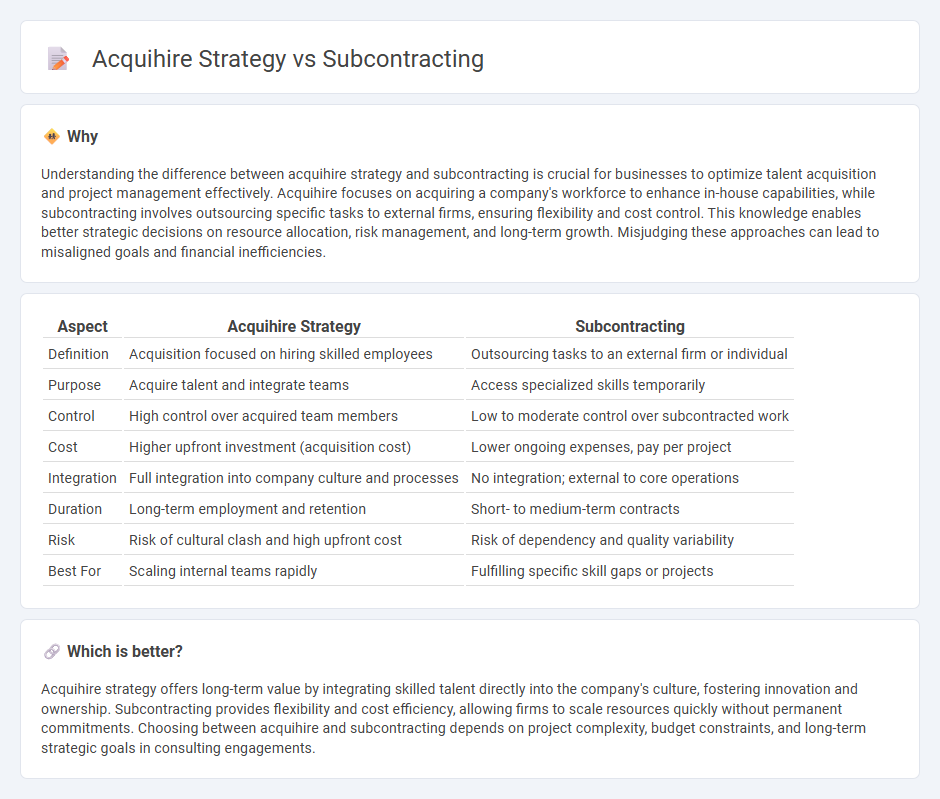
Acquihire strategy involves acquiring a company primarily to obtain its talent, providing long-term integration and control over expertise, while subcontracting focuses on outsourcing specific tasks or projects to external vendors for flexibility and cost-effectiveness. Acquihiring creates a seamless blend of new skills into the core team, enhancing innovation and company culture; subcontracting allows scalable resource allocation without permanent commitments. Explore more about how acquihire and subcontracting can shape your consulting approach for sustained growth and agility.
Why it is important
Understanding the difference between acquihire strategy and subcontracting is crucial for businesses to optimize talent acquisition and project management effectively. Acquihire focuses on acquiring a company's workforce to enhance in-house capabilities, while subcontracting involves outsourcing specific tasks to external firms, ensuring flexibility and cost control. This knowledge enables better strategic decisions on resource allocation, risk management, and long-term growth. Misjudging these approaches can lead to misaligned goals and financial inefficiencies.
Comparison Table
| Aspect | Acquihire Strategy | Subcontracting |
|---|---|---|
| Definition | Acquisition focused on hiring skilled employees | Outsourcing tasks to an external firm or individual |
| Purpose | Acquire talent and integrate teams | Access specialized skills temporarily |
| Control | High control over acquired team members | Low to moderate control over subcontracted work |
| Cost | Higher upfront investment (acquisition cost) | Lower ongoing expenses, pay per project |
| Integration | Full integration into company culture and processes | No integration; external to core operations |
| Duration | Long-term employment and retention | Short- to medium-term contracts |
| Risk | Risk of cultural clash and high upfront cost | Risk of dependency and quality variability |
| Best For | Scaling internal teams rapidly | Fulfilling specific skill gaps or projects |
Which is better?
Acquihire strategy offers long-term value by integrating skilled talent directly into the company's culture, fostering innovation and ownership. Subcontracting provides flexibility and cost efficiency, allowing firms to scale resources quickly without permanent commitments. Choosing between acquihire and subcontracting depends on project complexity, budget constraints, and long-term strategic goals in consulting engagements.
Connection
Acquihire strategy and subcontracting both serve as tactical approaches in consulting to quickly augment team capabilities and access specialized expertise. Acquihiring involves acquiring a company primarily for its skilled workforce, enabling seamless integration of talent and resources into existing operations. Subcontracting complements this by outsourcing specific project components to external experts, optimizing flexibility and efficiency in delivering consulting services.
Key Terms
Talent Acquisition
Subcontracting enables companies to access specialized skills and scale projects flexibly without long-term commitments, ideal for immediate technical needs. Acquihire strategies prioritize acquiring entire teams or key talent through company acquisitions, facilitating stronger cultural integration and retention of top performers. Explore how each method can transform your talent acquisition approach and business growth.
Cost Efficiency
Subcontracting leverages external expertise to reduce operational costs and enhance flexibility, making it ideal for businesses aiming to optimize budget allocations without long-term commitments. Acquihire focuses on acquiring talent through company acquisition, often involving higher upfront expenses but ensuring full integration of skilled teams to drive innovation and growth. Explore detailed comparisons to determine which strategy best aligns with your cost efficiency goals.
Intellectual Property
Subcontracting allows companies to outsource specific tasks or projects while retaining full ownership of intellectual property (IP) generated, ensuring control over patents, trademarks, and proprietary technology. Acquihire strategy involves purchasing a company primarily for its skilled team, often including existing IP assets, which can lead to integrated innovation but potential IP entanglements. Explore detailed comparisons to understand how each strategy impacts IP management and corporate growth.
Source and External Links
What is Subcontracting? Meaning, Advantages, Taxes [2025] - Subcontracting is the practice where a main contractor outsources specific tasks of a project to an external company or individual specialist, formalized through clear agreements covering scope, payment, deadlines, quality, and liabilities to ensure successful collaboration.
What is Subcontracting? Definition & Best Practices - Deltek - In government contracting, subcontractors work under prime contractors and do not contract directly with the government, typically providing specialized services or smaller-scale work as part of larger projects.
Prime and subcontracting | U.S. Small Business Administration - Federal subcontracting requires prime contractors to include small business subcontracting plans when awarding large contracts, setting goals for subcontracting to various small business categories and following regulatory limitations to ensure fair subcontracting opportunities.
 dowidth.com
dowidth.com